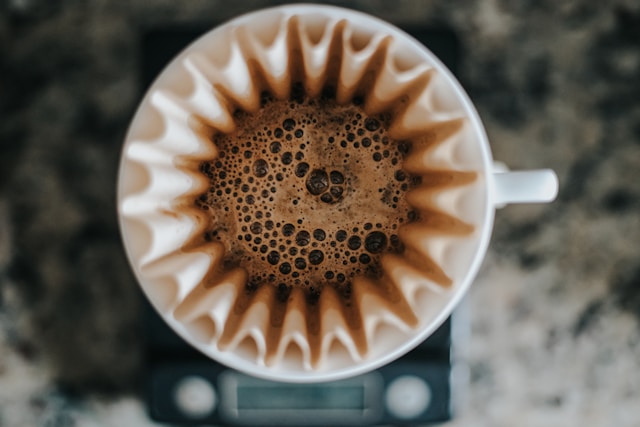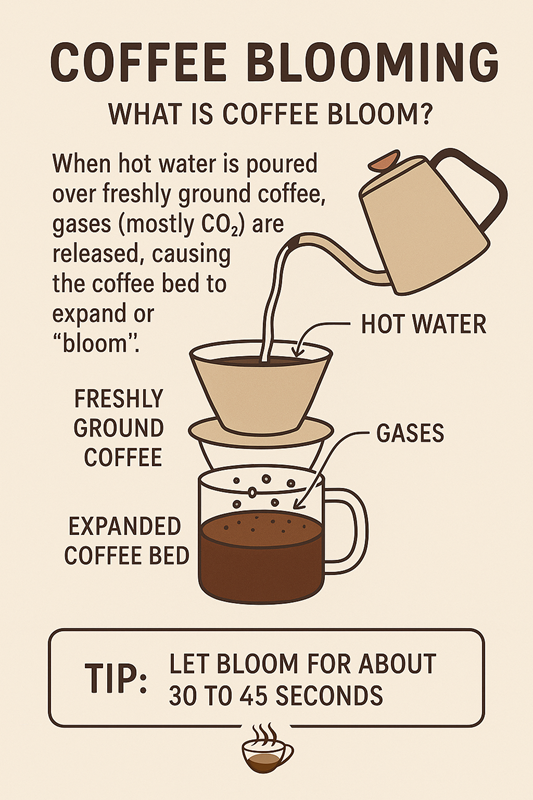Coffee bloom is the quick bubbling you see when hot water first hits freshly ground coffee. It happens because the water releases trapped carbon dioxide (CO₂) from the beans. A strong bloom is a good sign that the coffee is fresh. Blooming matters because it helps remove gases that can prevent water from soaking into the ground properly. This step ensures better flavor extraction, leading to a richer, smoother, and more balanced cup of coffee.

Ever notice coffee bubbling and puffing up when you brew it? That’s called coffee bloom! It’s a fun thing to watch, and it actually tells you a lot about the freshness and quality of your coffee.
Blooming occurs when hot water comes into contact with the coffee grounds and releases trapped gases. It’s a quick but important step for better taste and aroma.
In this guide, we’ll break down what coffee bloom is, why it matters, and how you can bloom coffee properly for a richer and more delicious cup of coffee
What is Coffee Bloom?
Coffee bloom is that puffy, bubbly rise you see right after you pour hot water over freshly ground coffee. It looks like the grounds are swelling up and fizzing a bit. That’s carbon dioxide (CO₂) escaping from the coffee, especially in pour-over methods like V60 or Chemex.
Blooming shows that the coffee is fresh. The fresher the coffee, the more CO2 it holds inside. So, the more it will bloom when water hits it.

You’ll see blooming most clearly in brewing styles like:
With pre-ground coffee or older beans, you may not see much of a bloom. That’s because most of the gas has already escaped over time.
Why Coffee Blooms? The Science behind it
When coffee beans are roasted, they heat up significantly, causing a buildup of carbon dioxide (CO2) inside the beans[1]. After roasting, the beans start to degas, meaning they slowly release the CO2. However, they don’t release all the gas at once.
When you grind the beans and pour hot water over them, the remaining CO2 escapes quickly. This causes the coffee to bubble and rise, which is known as “blooming.”
The blooming process is important because it helps prepare the coffee grounds for even extraction. This results in a better, more balanced flavor in your cup.
Why is Blooming Coffee important?
Here’s why blooming your coffee really matters:
1. It Improves Water Contact with the Coffee Grounds
When coffee is freshly roasted, it traps carbon dioxide (CO₂) inside the beans. If you don’t bloom the coffee, CO₂ can push water away from the grounds. That means water doesn’t fully extract the flavors, and you get a weak and flat-tasting coffee.
2. It Reduces Sour and Acidic Flavors
If CO₂ isn’t released during blooming, it dissolves in the brewing water and forms carbonic acid. That acid gives your coffee a sharp, sour taste—kind of like fizzy water but not in a good way. Blooming lets the gas escape early, so the final brew tastes smoother and cleaner.
3. Improves Extractions
Proper blooming improves extraction consistency. When coffee grounds are evenly saturated during blooming, they extract more uniformly during the full brewing process.
Is it really necessary?
In most cases, yes. But there are a few times when blooming isn’t really needed.
- Pre-ground or Old Coffee Bean: Most of the gas is already gone. So there will not be much blooming.
- Espresso Machines: These use high pressure to extract coffee fast. You’ll not notice any blooming.
- Drip Coffee Makers: Some modern machines have a “pre-infusion” or bloom mode. But older models might not.
How to Bloom Coffee Properly?
Here’s how to bloom coffee using different brewing methods, with a few tips to help you get the best results:
Pour-Over Blooming (V60, Chemex, etc.)
- Start with freshly ground coffee in your filter or pour-over device.
- Heat the water to just below boiling (195°F to 205°F). This is the ideal range to prevent burning the coffee for the best flavor.
- Slowly pour a small amount of water (about twice the weight of your coffee grounds), just enough to wet all the grounds evenly.
- Let the coffee grounds bloom for 30 to 45 seconds. This is when the CO2 is released, causing the coffee to bubble and rise.
- After the bloom, pour the remaining water in slow, controlled circles, ensuring all the grounds are evenly saturated.
Pro Tip: Pouring in a spiral pattern ensures an even bloom and consistent extraction, helping you avoid over-extraction from some areas and under-extraction from others.
French Press/Aero Press Blooming
Blooming in a French press is not a necessary step, as it is in pour-over methods. However, if you are using Fresh Coffee beans it is recommended to let it bloom for around 30 seconds.
How to Do It:
- Add your coarsely ground coffee to the French Press or Aero Press.
- Pour hot water (about double the amount of coffee) to saturate the grounds.
- Let it sit for 30 to 45 seconds to allow the CO2 to escape.
- After blooming, pour in the rest of the hot water and place the lid on.
- Let it steep for 4 minutes, then gently press down to extract the coffee.
Pro Tip: Gently swirling the French Press after the bloom period helps mix the coffee and water evenly before pressing.
Drip Coffee Makers
- Some drip coffee makers automatically bloom the coffee with a pre-infusion feature. This feature wet the grounds with a small amount of water before brewing starts. If your coffee maker has this feature, you don’t need to do anything extra.
- If your coffee machine doesn’t have a pre-infusion feature, you can manually bloom your coffee by starting the brew cycle, pausing it after about 30 seconds, and then resuming. This pause allows the coffee grounds to bloom before the full brewing process continues.
Pro Tip: Manually pausing the brew cycle helps improve the coffee’s flavor, though it’s less controlled than manual pour-over methods.
Should you Bloom Espresso?
No, you don’t bloom coffee when using an espresso machine. Espresso machines work totally differently from pour-over or drip methods. The machine already handles pre-infusion (espresso’s version of blooming) by pushing a small amount of water through the puck at high pressure before the full extraction.
Blooming FAQs
How much water should be used to bloom coffee?
For Blooming, use a coffee-to-water ratio of about twice the weight of the coffee grounds. So if you’re using 15 grams of coffee, bloom with about 30 grams of water. This is just enough to wet all the grounds without starting the full brew too early.
How long should you let the coffee bloom?
Let the coffee sit for 30 to 45 seconds during blooming. That’s enough time for most of the CO2 to escape. Waiting longer won’t always improve the taste. In fact, it can lead to over-extraction.
Should you bloom using hot or cold water?
Always use hot water for blooming, ideally between 195°f and 205°f. Cold water won’t trigger the same reaction or release the gas properly.
Can you over-bloom coffee?
Yes, you can over-bloom your coffee ff you let the bloom phase go longer than 45-60 seconds. Over-blooming can lead to over-extraction, pulling out bitter compounds that ruin your perfect cup. Stick to a 30-45 second bloom time for that ideal balance of flavor release without the drawbacks.
Why is your coffee not blooming?
Your coffee may not bloom if it’s too old, pre-ground, stored improperly, or made from low-quality or poorly-roasted beans. Freshness, good storage, and bean quality are key for a lively bloom.
What are the factors that affect blooming?
Several things can impact how your coffee blooms. Understanding these can help you make small changes that lead to a much better cup.
Let’s take a closer look:
1. Coffee Freshness
Freshly roasted beans contain more CO2, creating a lively bloom. Beans roasted within the last 2 weeks will bubble up significantly when hot water hits them. Older beans have already released much of their gas naturally, resulting in a weaker bloom and often a flatter taste.
Tip: Beans roasted within the last 2-4 weeks hit the sweet spot – use them during this window for best results. Coffee that’s too fresh (less than a week after roasting) can actually bloom too vigorously, causing uneven extraction, while beans older than a month will barely bloom at all.
2. Proper Coffee Storage
Exposure to air, moisture, heat, and light causes beans to degas faster. Proper storage helps maintain the freshness of the beans
3. Roast Level
Darker roasts typically bloom more vigorously than lighter roasts because the longer roasting process creates more CO2. Light roasts still need blooming but may show a subtler reaction.
Read a Guide on Light vs Dark Roast Coffee
4. Pouring Technique
How you introduce water matters! A gentle, circular pour distributes water evenly and creates a consistent bloom. Dumping all the water in one spot can create channels and uneven extraction.
Tip: Use a gooseneck kettle for precise control over where and how fast the water hits your grounds.
Check out Related Articles:
References:



